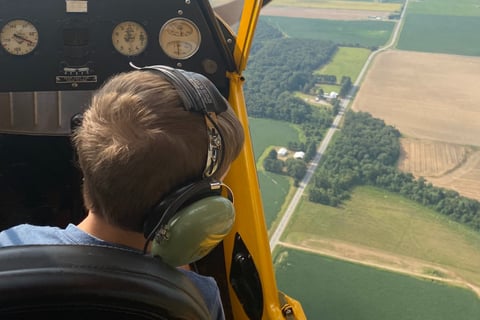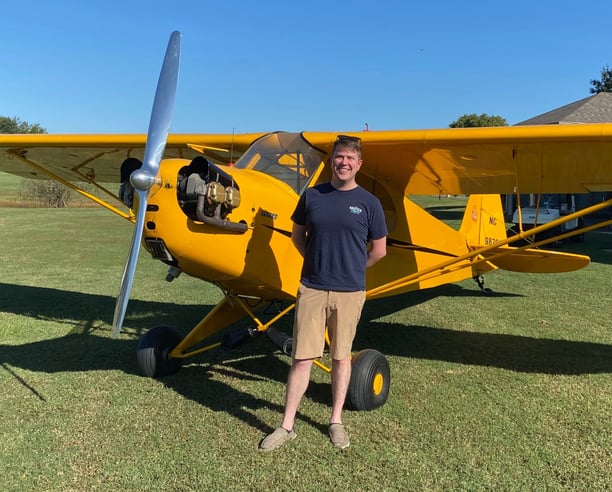According to AOPA statistics, it takes 6 to 12 hours of dual flight time for most pilots to safely achieve proficiency. The hour requirements may differ for insurance purposes when renting/buying a taildragger aircraft. As always with flying, a lot depends on your previous skills and frequency of flying.
Taxi
During flight training, taxi using normal flight control inputs based on prevailing winds. Taxi SLOW using S turns to maintain visibility at all times.
Takeoff
During flight training, we all learned the effect of torque and slipstream. Be aware these forces try to steer you left once you begin your takeoff.
Additionally, two other forces also affect a taildragger. The other forces are P-factor and gyroscopic precession. P-factor is the asymmetric force produced when a propeller disc meets oncoming airflow at an angle.
There is already a tilt to the propeller due to the angle at which a taildragger sits on the ground. When you apply power and begin moving, the descending blade takes a bigger bite of air. On taildraggers, P-factor amplifies the effect of torque and slipstream, swinging you left.
Gyroscopic precession is the force felt when you change the plane of a spinning disc, with the force felt at 90-degrees to its point of application.
In a taildragger, raising the tail upon takeoff causes precession to yaw the aircraft left.
Let’s look at the forces on a tailwheel aircraft during takeoff. You apply power, and immediately slipstream and torque effect tries to turn you left, so you put in lots of right rudder. As you accelerate and gain rudder greater authority, you can begin easing off the rudder input.
P-factor is trying to turn the airplane left the moment you begin moving, but once you raise the tail and meet the airflow head-on, it stops. You will need lots of rudder to start with, then less to counter the P-factor. Precession only occurs while you are raising the tail on the takeoff run, so it will try to steer you left as you raise the tail.
Once the tail is up, it ceases until you rotate into the climb, at which point it tries to steer you right. So your rudder application for precession involves no rudder, right rudder, then easing off the right rudder.
Remember the CG location? Every swing or movement of the aircraft described above requires you to stop it. It will not self-correct. In a tailwheel aircraft, constant rudder input in both directions is required to maintain a straight line during take-off.
Landing
Landing a tailwheel aircraft demands a similar focus to that required during take off. The high AoA of the wing means you must continue to fly the aircraft while on the ground. Continue to monitor heading, roll, and pitch, correcting immediately if you sense a diversion. Maintaining centerline on the runway is imperative. If you cannot land after bouncing twice during touch down, you must add power and go around.
There are two landing options in a tailwheel aircraft, a three-point landing or a wheel landing.
A three-point landing involves touching the mains and tailwheel at the same time. If we touch the mains slightly early, and the tail drops, increasing the wing AoA… the aircraft lifts off again. You’ll need to catch this and flare again, sometimes with power, to get the aircraft landed correctly. Once the tailwheel is down, you need to keep it there with full aft elevator to maintain directional stability.
A wheel landing requires touching the main wheels first and keeping the tailwheel elevated with a slight forward check on the elevator control. You maintain directional stability with the rudder, allowing the tailwheel to touch down on its own accord. You then apply full aft elevator.
When flying a taildragger, the adage of flying the aircraft until the hangar doors are closed is particularly appropriate. A ground loop is an uncontrolled sharp turn that occurs during taxi, takeoff, or landing and rollout. It happens when the pilot allows a swerve to go unchecked, at which point momentum begins to build. The center of gravity takes over, and if unchecked, can result in some unpleasant behavior.
To prevent a ground loop, the pilot must use decisive rudder inputs to stop any swerve immediately. Once the momentum is stopped, the control inputs must be rapidly neutralized to avoid the opposite swing from starting.
Back To Those FAA Requirements...
From the discussion above, you can understand the FAA’s focus on takeoffs, landings, and go-arounds. During these operations, the forces in play from a tailwheel aircraft require a pilot to be alive to its movements, calling on alertness and responsiveness.
Required training for the tailwheel endorsement per 14 CFR § 61.31 consists of: Normal and crosswind takeoffs and landings (3 point), Wheel Landings and Go-around procedures
Your tailwheel training will also cover the following additional items to enhance your flying and risk management skills:
Slow flight, power-on, and power-off stalls, steep turns, Power-off 180-degree approaches and landings, Forward slips, Grass strip operations, Emergency procedures, and anything else you request to enhance safety and your proficiency and confidence.
Training typically begins with a ground briefing, taxiing, and maneuvers in the practice area. We will begin flying in the practice area, at altitude, to allow you to gain proficiency with coordinated flight and have no doubt where the airplane stalls. We follow that with takeoffs and landings on grass to learn the basics. From there, you will start practicing takeoffs and landings on pavement.
Summary
The skills you learn in a tailwheel aircraft will apply to all aspects of your flying. Your situational awareness during critical flight phases increases. So too does your use of rudder; you’ll find your turn coordination improves from not leaving your feet frozen on the pedals. There is also the satisfaction of mastering a new skill in an aircraft that can take you places many others can’t. We highly recommend it!
We have a passion for Tail Wheel Aviation!
The Tail Wheel Endorsement
The Regulations
Regulated by CFR 14 Part 61.31, tailwheel training must be received from an authorized instructor to receive the tailwheel endorsement.
The FAA requires the following minimum maneuvers and procedures:
Normal and crosswind takeoffs and landings, Wheel landings, and go-around procedures.
There are no minimum number of hours required by the FAA to achieve a tailwheel endorsement, however, it does take some practice to become proficient and confident.



★★★★★
“Jay was a phenomenal instructor. As a corporate pilot and busy GA flier and fabrics expert, he has a great deal of knowledge to share. He’s also the type of instructor who lets you make small mistakes since those provide great learning moments. Jay is very patient and gracious with teaching techniques, given that it all happens in the space of tailwheel flying, where there’s less margin for error! I highly recommend him for your tailwheel initial or to brush up on any advanced technique you need”


Mark Stanfield ATP, CFI, Airbus First Officer
